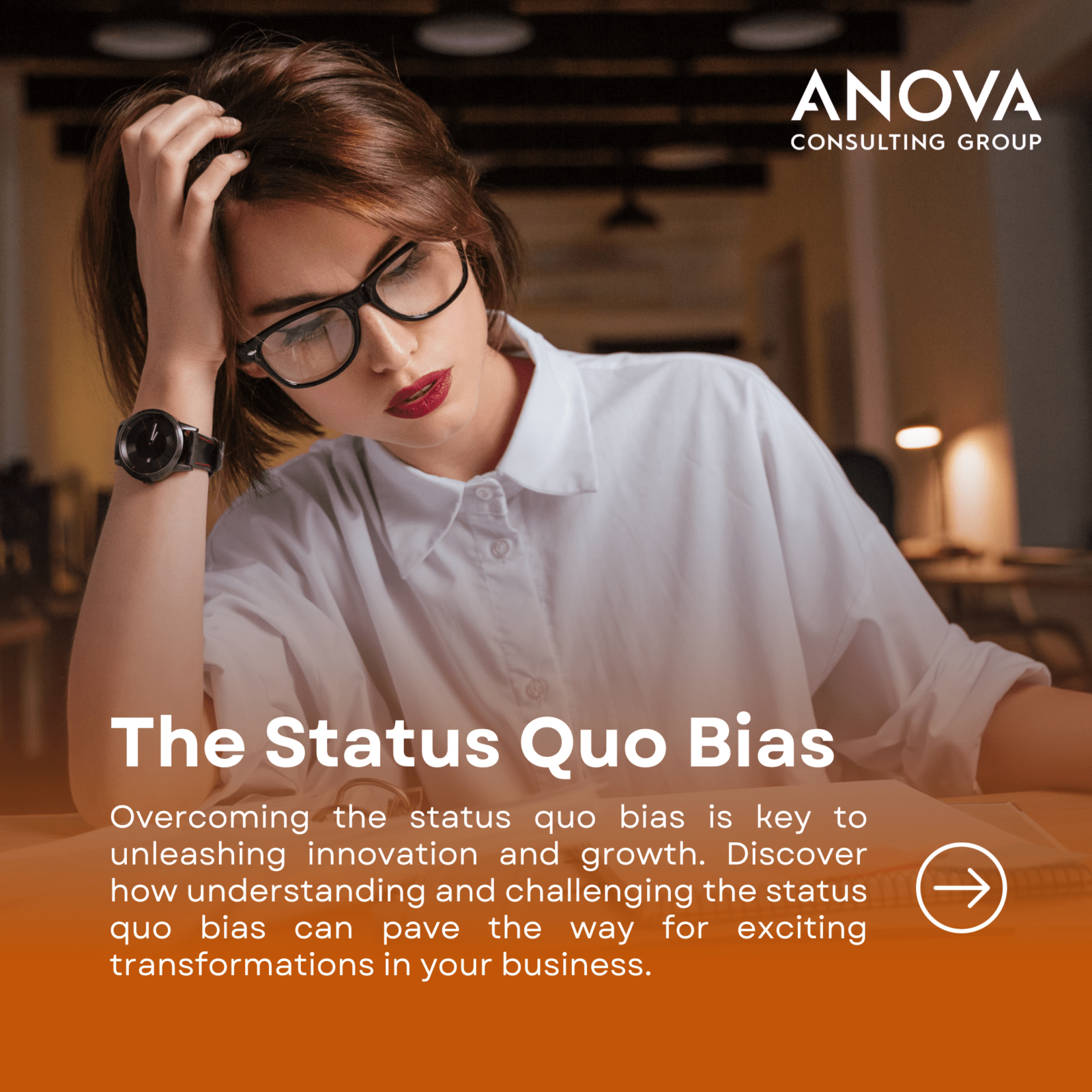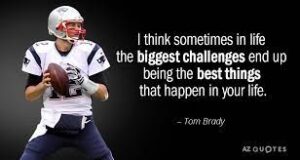

 This blog was written by Harriet Peabody, Research Analyst at Anova.
This blog was written by Harriet Peabody, Research Analyst at Anova.
Status quo bias is a cognitive bias that leads people to prefer the current state and resist change. This bias can be seen in many different areas of life, from personal decision-making to organizational decision-making.
In the context of organizations, status quo bias can lead to several problems, including:
A failure to innovate. Organizations that are stuck in the status quo are less likely to develop new products and services, or adopt new ways of doing things, putting them at a competitive disadvantage.
A failure to meet customer needs. Customers’ needs and expectations are constantly changing. Organizations that don’t listen to their customers’ feedback and make changes accordingly are at risk of losing their customers to competitors.
A failure to adapt to change. The business world is constantly changing, and organizations that don’t adapt to change are likely to fall behind their competitors.
Voice of the customer (VOC) feedback is a way to collect and analyze customer feedback to better understand their needs, expectations, and pain points. By listening to VOC feedback, organizations can identify addressable areas that will directly benefit their customers.
VOC feedback can help organizations avoid status quo bias in a number of ways:
It provides a fresh perspective. VOC feedback comes from customers with different perspectives than employees, helping organizations identify areas where they are falling short of customer expectations.
It identifies areas for improvement. VOC feedback helps organizations identify weaknesses and implement improvement plans that address customer needs.
It provides evidence for change. VOC feedback provides crucial evidence to support the need for change, helping overcome potential resistance from employees and other stakeholders.
Anova helps clients avoid status quo bias not only by providing VOC feedback in the form of win/loss, customer satisfaction, and customer churn programs, but also by generating actionable insights from the VOC data. Clients learn directly from the customer what they need to do to stay competitive, coming away with ideas on how they can begin making improvements. Additionally, Anova’s competitive benchmarking data helps clients prioritize areas for improvement by comparing client results to others in their industry. Keeping up on competitor innovation drives organizations to innovate themselves to avoid falling behind.
The Anova value of a growth mindset means that we as a team are ‘content but never complacent.’ Rather than sticking to the status quo and an ‘if it ain’t broke, don’t fix it’ mindset, we push ourselves to continuously improve and better serve our clients. This involves being receptive to feedback as well as pushing ourselves outside of our comfort zone to embrace change. Using VOC data combined with a commitment to being open to change, data driven, and customer centric, Anova aims to ensure our clients are well-positioned to remain competitive and win more deals by virtue of avoiding intrinsic status quo bias.
 The COVID-19 pandemic has reshaped the way businesses operate, with remote work becoming a defining trend. Sales teams are no exception, as they’ve increasingly turned to videoconferencing for meetings and presentations. While remote sales may have been on the horizon, the last few years accelerated this shift, leaving teams to adapt to virtual interactions without as many traditional face-to-face connections.
The COVID-19 pandemic has reshaped the way businesses operate, with remote work becoming a defining trend. Sales teams are no exception, as they’ve increasingly turned to videoconferencing for meetings and presentations. While remote sales may have been on the horizon, the last few years accelerated this shift, leaving teams to adapt to virtual interactions without as many traditional face-to-face connections.
According to a HubSpot report published in September 2022, 68% of sales leaders are planning to adopt either a hybrid or fully remote sales model. In this changing landscape, sales teams must uphold traditional sales principles like responsiveness, consultative approaches, and demonstrating expertise. However, they also need to acquire new skills to build rapport and relationships through a screen.
Here are key tips for effective remote sales calls:
Preparation and rapport building: Small talk, which naturally occurs in in-person meetings, may take time to develop on video conferences. To foster this, come prepared with relevant topics for your audience. For new prospects, research their professional and personal interests from sources like LinkedIn and company bios. For existing clients, consult the team servicing them for insights.
Balancing content and conversation: Keep your camera on to establish a personal connection and use visuals like slides and images to convey your message effectively. Alternate between sharing content directly related to your sales story and turning off sharing during more conversational moments to mimic face-to-face discussions.
Amplify non-verbal cues: On videoconferencing, the focus is often limited to the speaker’s face. Use body language, gestures, and hand signals to enhance your message and presentation. If possible, position yourself further from the camera to ensure your hands are visible. Bring your hands closer to your face when emphasizing points or counting down agenda items.
Active listening: Virtual presentations can sometimes feel one-sided. Pause at regular intervals to encourage questions and revisit previously covered areas. This not only engages the audience but also addresses any questions or concerns they might have.
Multiple voices: A single-voiced presentation can lead to audience disengagement over time. Assign different sections of the sales presentation to various team members. If possible, bring in experts from your team, like implementation or client support members, to address specific communication points.
The shift toward remote sales is here to stay, offering benefits such as increased reach, flexibility, reduced travel expenses and decreased carbon footprint. To succeed in this changing landscape, sales teams must adapt and evolve. While there’s no one-size-fits-all approach, these tips can help B2B sales teams adjust their strategies to optimize remote presentations.
 There are many different methods to go about analyzing and understanding the overall satisfaction of your client base. But beyond this overall score, which is rating a vast number of your clients, are the sentiments of individual customers.
There are many different methods to go about analyzing and understanding the overall satisfaction of your client base. But beyond this overall score, which is rating a vast number of your clients, are the sentiments of individual customers.
Would you want to know exactly which of these clients are the unhappiest and why?
Most likely, your answer to the question above is affirmative. After all, these are the clients that are most at risk for leaving you, and as Bill Gates said, “Your most unhappy customers are your greatest source of learning.”
But how do you find out which clients fall into the At Risk category and what specifically is behind their dissatisfaction? The answer is right inside your client satisfaction program approach. By taking your client satisfaction study one step further, you can identify who these clients are and respond with personalized service that can save that potential ambulatory revenue from walking out on you.
Consider, perhaps, a couple new techniques. One technique is to ask a series of questions gaging your clients’ satisfaction with different attributes regarding the relationship. For example, you can ask them to rate how they feel about the value of your products and services relative to the fees paid, how they are treated as an important client, and their willingness to recommend your organization to someone else.
By uncovering and seeing your clients’ sentiments regarding these attributes, you will be able to determine who is not feeling satisfied with pivotal aspects of the relationship and who would consider leaving for someone else. The responses to these questions can also dig deeper into areas that the client may not have considered when rating their overall satisfaction.
Another technique is to openly ask your clients to rank their likeliness to continue the relationship with your company on a sliding scale. While slightly more brazen, it will be easy to decipher these more direct answers and understand which clients are At Risk.
As noted, after identifying these At Risk customers, it is important to follow-up with a personalized discussion. Look at the ratings for all the other attributes in your survey to identify which are the lowest, and (most likely) driving their dissatisfaction, and speak to how you plan on improving their experience regarding their pain points. Having the personalized discussion will show you care, have paid attention to their dissatisfaction, and are committed to improving the relationship.
Engaging a third-party to gather feedback from clients can be an invaluable strategy to obtain honest and unbiased insights. Having an external, investigating party provides a level of objectivity that clients may feel is lacking in internal surveys, making them more comfortable sharing their genuine thoughts and concerns. Third-party feedback is also often seen as credible and impartial, which can encourage clients to be more open in their responses. You can ensure that your survey is being conducted by people who are skilled at analyzing the data and transforming it into actionable recommendations. This invaluable insight enables your business to take swift and effective action to address client needs, enhancing overall satisfaction and client retention. The objective perspective and expertise of a third-party service can be a game-changer in creating a more client-centric approach to your business.
 Given that a large majority of sales processes and presentations are now conducted virtually, with call recordings readily available, “game tape” review is an easy addition to team training efforts.
Given that a large majority of sales processes and presentations are now conducted virtually, with call recordings readily available, “game tape” review is an easy addition to team training efforts.
Watching yourself on screen or listening to your own recorded voice in the company of colleagues can be a daunting experience, but game tape sessions are invaluable. There is a lot you can learn by watching your own performance, but incorporating outside viewpoints can lead to even more fresh insights and opportunities for improvement.
While the specific approach to conducting game tape sessions may vary among organizations, here are some essential tips for facilitating them effectively:
Foster trust and openness: At the outset, emphasize that game tape sessions are designed to facilitate improvement and enhance team success. This approach will help team members feel comfortable and minimize unease.
Embrace constructive criticism: Although receiving praise is always nice, the true benefit of these sessions lies in identifying areas for improvement. Recognize that no interaction is perfect, and welcome constructive feedback on parts of the interaction that could have gone better, in addition to reinforcing behaviors to repeat and emphasize.
Apply lessons learned: Implement the insights gained from these sessions in your future interactions, both in terms of what to do and what not to do. Adjust your talking points and visual aids. View these lessons as building blocks toward achieving more polished interactions.
Maintain continuity: Establish a continuous feedback and improvement cycle. At Anova, these sessions are a regular part of our internal processes because we believe in craftsmanship. There is always room for enhancement and growth, and we have found that everyone on the team benefits by reacting to their teammates’ performance; it accelerates their learning, as well.
Similar to how professional athletes and sports teams rely on game tape sessions to optimize their performance, implementing such sessions in a sales organization fosters a culture of accountability and continuous improvement.
 “If I only knew then what I know now.” Have you ever thought that? Most likely your answer is yes. We all have. This common phrase is usually used when talking about life lessons such as relationships, opportunities, and decisions. But it also applies to business, an experience that is full of life lessons – yes – relationships, opportunities, and decisions.
“If I only knew then what I know now.” Have you ever thought that? Most likely your answer is yes. We all have. This common phrase is usually used when talking about life lessons such as relationships, opportunities, and decisions. But it also applies to business, an experience that is full of life lessons – yes – relationships, opportunities, and decisions.
Consider your clients, both past and present. Could you learn from your past clients that have left you for a competitor? What if you knew that 1 out of every 4 departed clients had no intention of leaving your organization at the onset of looking at another provider? In truth, not all departed clients were looking to leave.
In its purest form, Customer Churn research helps an organization understand why clients have left their organization for a competitor. Why does the story have to end there though?
When an organization uses Customer Churn research to develop insights and strategies that will retain existing clients, the ultimate benefit of such a program occurs. And if organizations are retaining clients, they are fueling corporate goals and adding to their bottom line.
You may be asking, “What’s the cost connection between retaining existing clients and saving my organization money?” Simple: It costs roughly 7 times more to acquire a new customer than it does to keep an existing one. When you factor in the cost of marketing, sales efforts, and onboarding for new clients, it becomes clear that retaining your existing client base is not only beneficial but cost-effective.
So, look back and discover how you can know now what you did not know then. Your past, present and future clients will appreciate it and so will your organization’s leaders. By retaining existing clients, you’ll not only safeguard your organization’s reputation but also save resources that can be redirected towards growth and innovation.
To read more about the benefits of Customer Churn analysis, check out other Anova Blog posts:
The Doctor is In: How Departed Client Analysis is Like Getting an Annual Physical
It’s Over: Life after a Client Ends the Relationship
Closure: Giving Customers the Final Word

The Anova team is thrilled to share the results of our recent internal client satisfaction study. We’re proud to report that 92% of our clients are satisfied with our work, and 100% say we have met or exceeded their expectations. These statistics speak to our commitment to delivering high-quality services and achieving our clients’ business goals.
We help clients win.
86% of our clients say our unique approach to Win/Loss has helped them win and retain more business, and 88% say we have improved their sales effectiveness. These clients point to our direct interviews with key decision-makers as the path to gain deep insights into their markets, competitors, and customers. One satisfied client said, “The quality of Anova’s interviewing process is great. Other Win/Loss providers rely on web-based and non-personal surveys, which are much less effective. Anova’s interviews are superb.”
We provide clients with a clearer understanding of their competitive landscape.
Our services, whether Win/Loss, Client Satisfaction, or Churn Analysis, have helped our clients better understand their competitors and their markets. 88% of our clients claim that we have helped them to improve their competitive intelligence. This enables them to make data-driven decisions that improve their business. According to another satisfied client, “[Anova] understands our market and provides us with good competitive intelligence. They add meaningful value from a strategic standpoint and are very credible as it relates to understanding our industry.”
We foster collaboration.
79% of our clients say our work has improved cross-functional collaboration within their organization. This is because our services provide a unified understanding of the market, competitors, and customers, which leads to a more coordinated and effective approach to decision-making. As one client said, “The information is valuable. The way that Anova writes up the information and provides insights is valuable. The key part is how we understand our place in the competitive market, our sales approaches, and how our products are perceived. We take this information to heart. Win/Loss is a factor in driving change across our organization.”
At Anova Consulting Group, we take pride in providing our clients with insights that help them make data-driven decisions, win and retain more business, and improve their overall effectiveness. We are committed to delivering high-quality services that align with our clients’ business objectives and exceed their expectations. Our clients’ success is our success, and we work tirelessly to ensure they achieve their goals.
 Anova Consulting believes that one of the keys to success lies in the ability to adapt and learn from the challenges we face. These shared beliefs, essentially our corporate ethos, are values we strive to put into action every day. This is the final in a series of blogs that explore Anova’s values through the lens of people we feel embody them.
Anova Consulting believes that one of the keys to success lies in the ability to adapt and learn from the challenges we face. These shared beliefs, essentially our corporate ethos, are values we strive to put into action every day. This is the final in a series of blogs that explore Anova’s values through the lens of people we feel embody them.
It happens a lot: a group or team is in crisis mode. Something negative or adverse happened, and people are wondering, “Why did this happen, and who can we blame?”
Like the very best leaders and teammates, former football pro QB Tom Brady never waited to accept accountability. One game, after turning the ball over four times in a loss, Brady admitted to his teammates and fans, “That was on me. I’ve got to be better for my team, for our organization, for our fans. There are different ways to handle adversity, and my way is to take accountability for my actions.”
“Accountability is a life skill that greatly helps with overall life success,” says Dr. Christopher Stankovich, Ph.D., founder of Advanced Human Performance Systems, an athletic counseling and human performance enhancement center. He sees accountability as a successful contract between manager and employee, coach and athlete, and parent and child. “Whether it’s being accountable for training, studying, or making a meeting on time, accountability helps build trust between individuals, and trust leads to stronger overall relationships,” he says. “People that emphasize accountability generally get things done better and faster than those who do not hold themselves accountable.”
People who are assigned responsibilities are empowered with the trust to adequately handle them. They should also accept that they are accountable for those responsibilities, regardless of what happens. “There are ways you can handle adversity,” says Brady. “One is you point fingers at people, which we don’t do. Another is you quit and that’s not what we do either. The last thing is you point at yourself. That’s accountability. That’s what we do.”
It’s also common practice at Anova. We encourage everyone here to take full responsibility for their actions—good, bad, or somewhere in between. Sharing accountability has strengthened us as a company and has helped us sustain many honest, transparent, and high-performing partnerships.
 Anova Consulting believes that one of the keys to success lies in the ability to adapt and learn from the challenges we face. These shared beliefs, essentially our corporate ethos, are values we strive to put into action every day. This is the sixth in a series of blogs that explore Anova’s values through the lens of people we feel embody them.
Anova Consulting believes that one of the keys to success lies in the ability to adapt and learn from the challenges we face. These shared beliefs, essentially our corporate ethos, are values we strive to put into action every day. This is the sixth in a series of blogs that explore Anova’s values through the lens of people we feel embody them.
Feedback is present in nearly every worthwhile endeavor. One great example of someone who truly embraces feedback as a gift is the multitalented Lin-Manuel Miranda. Miranda is best known as the creator of the hit musicals In the Heights and Hamilton. But his passion for telling great stories and writing great songs began long before his Broadway success. As a teenager, he would write and perform for family and friends, constantly seeking feedback and constructive criticism from anyone offering it.
In interviews, Miranda has spoken about feedback—both giving it and receiving it—as an integral part of the creative process. He once said, “Your critics are the ones who tell you what you need to hear. The praise doesn’t mean anything.”
A striking example of Miranda’s appreciation for feedback came during the development of Hamilton. During a workshop of the show, he was struggling to write a pivotal moment in the second act. He shared his frustration with director Thomas Kail, who offered him tough love: “You can’t tell people Alexander Hamilton’s entire life story in one song. Figure out what’s important.”
Miranda took Kail’s advice to heart and ultimately wrote the show-stopping number “It’s Quiet Uptown,” which beautifully captures the grief and healing of the Hamilton family after the death of their son.
Miranda’s willingness to embrace feedback doesn’t just apply to his creative work. He’s also been open about his struggles with anxiety and depression and how therapy and feedback have helped him manage those challenges. In an interview with GQ, he said, “The biggest thing that therapy has taught me is the act of listening, whether it’s to my wife, my cast mates, or my collaborators; really, really listening and taking in the information that is being given to you, instead of just waiting for your turn to speak.”
Here at Anova, we share Miranda’s belief that feedback is truly a gift. It’s an integral part of our process, whether we’re conducting win / loss surveys, or customer satisfaction research. We know that sometimes feedback can be tough to hear and difficult to process. But we also know that it’s essential.
 Anova Consulting believes that one of the keys to success lies in the ability to adapt and learn from the challenges we face. These shared beliefs, essentially our corporate ethos, are values we strive to put into action every day. This is the fifth in a series of blogs that explore Anova’s values through the lens of people we feel embody them.
Anova Consulting believes that one of the keys to success lies in the ability to adapt and learn from the challenges we face. These shared beliefs, essentially our corporate ethos, are values we strive to put into action every day. This is the fifth in a series of blogs that explore Anova’s values through the lens of people we feel embody them.
Craftsmanship refers to quality. It relates to workmanship. And it refers to the pursuit of excellence in execution. Antonio Lopez Garcia, a distinguished and respected Spanish painter, embodies the concept of craftsmanship through his total commitment to perfection.
Born in Tomelloso, Spain, in 1936, Lopez Garcia is widely regarded as a master of realism. He is best known for producing beautifully detailed paintings that capture the essence of everyday Spanish life, from the moody streets of Madrid to the evocative landscapes of his hometown.
A description of his work in an exhibition at the Museum of Fine Arts in Boston explains Lopez Garcia’s uncanny attention to detail: “Garcia will put aside a canvas until the light of a particular time of year returns. These long separations from his projects and the inevitable revisions that come from new observations require even more time. Such uncompromising devotion has made his artistic process the stuff of legend.”
In his painting “Gran Via,” for example, Lopez Garcia employs a technique known as hyperrealism, which involves the rendering of objects to create the illusion of reality. The result is an extraordinary portrayal of an eerily empty Madrid street scene. The painting painstakingly records every detail, from the reflections in the windows to the subtle variations in color and light. Interestingly, the painting is dated 1974-1981, as he would only work on it early Sunday mornings when the city’s streets were empty.
Craftsmanship as a concept sets not only the best artists apart from their competitors but the best companies as well. By striving for perfection in their craft, great companies create an organic culture of excellence that permeates every aspect of their business, from product development and customer service to communication. At Anova, we are committed to craftsmanship and feel this type of approach and this attention to detail gives us the best chance to meet our client’s objectives and achieve success of our own.
 Anova Consulting believes that one of the keys to success lies in the ability to adapt and learn from the challenges we face. These shared beliefs, essentially our corporate ethos, are values we strive to put into action every day. This is the fourth in a series of blogs that explore Anova’s values through the lens of people we feel embody them.
Anova Consulting believes that one of the keys to success lies in the ability to adapt and learn from the challenges we face. These shared beliefs, essentially our corporate ethos, are values we strive to put into action every day. This is the fourth in a series of blogs that explore Anova’s values through the lens of people we feel embody them.
Cultivating a strong company culture is critically important to ensure a company’s long-term success. Warren Buffett, CEO of Berkshire Hathaway, is renowned for many things. But near the top is his firm belief in the power of a positive company culture. He has built his own company around this very principle.
At the heart of the Buffett approach is that a strong company culture begins with the idea of “good people, great team.” Building a team of talented, motivated, and ethical individuals with shared values and goals is essential to creating a positive work environment. He believes it’s vital to hire people not simply based on their skills and experience but on their cultural fit with the company.
Buffett emphasizes professional development and mentorship. He often takes top executives under his wing and encourages them to develop their own investment philosophies. This has helped to create a culture of innovation and autonomy within Berkshire Hathaway, where employees feel empowered to make decisions and take risks.
Transparency and ethics are other important elements of Buffett’s approach to fostering a positive company culture. He refuses to invest in companies that engage in unethical or illegal practices, and he emphasizes the importance of being transparent with stakeholders. This approach has helped him build trust and credibility with customers, investors, and employees.
Buffett also places great importance on creating a sense of community for his employees. He believes that nurturing strong relationships among team members creates a supportive and engaged work environment. This includes encouraging coworkers to spend time together outside of the office and providing opportunities for team-building.
Anova believes the “good people, great team” ethos and strives to put it into practice with professional development, ethical behavior, transparency, and community-building. We also notice these elements in the company cultures of our most successful clients.